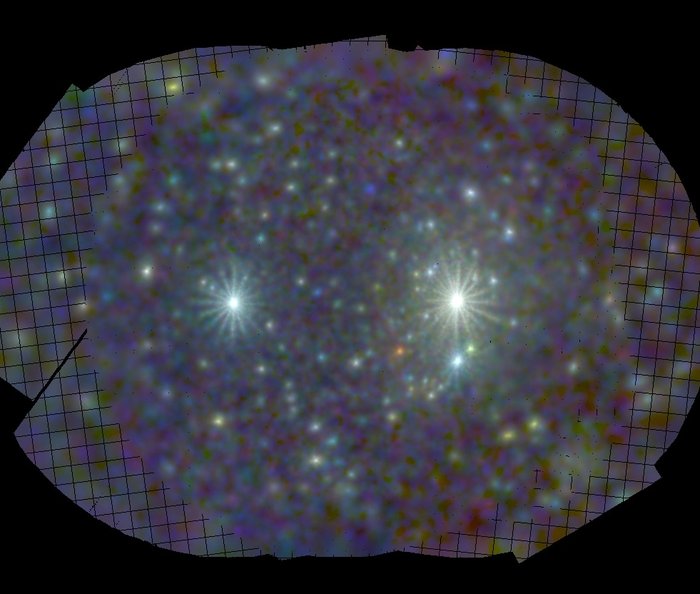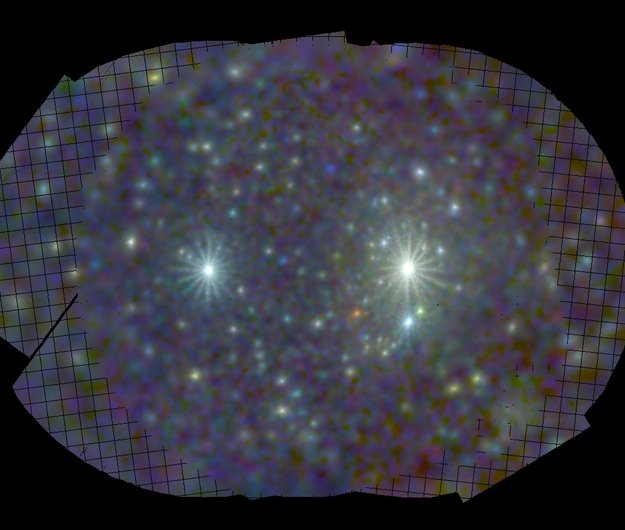http://www.esa.int/esl/ESA_in_your_country/Spain/Brillad_brillad
Brillad, brillad...
19 diciembre 2016
Una parte importante del estudio de los objetos celestes consiste en detectar y eliminar el ruido de fondo.
La imagen que hoy nos ocupa fue creada para demostrar la eficacia de las herramientas de software utilizadas para analizar las observaciones que el satélite XMM-Newton de la ESA realiza de grandes objetos, como galaxias, cúmulos de galaxias y remanentes de supernovas.
Esta herramienta en concreto modela y sustrae el ruido de fondo, algo muy difícil en el caso de objetos grandes y difusos como estos, para crear imágenes con una exposición corregida. También fusiona y suaviza las observaciones realizadas de un determinado objeto por las tres cámaras de rayos X del instrumento EPIC (Cámara Europea de Imágenes de Fotones), permitiendo crear mosaicos a partir de distintas observaciones.
Aunque no lo parezca, la formación estelar de la derecha corresponde a la galaxia espiral M81. Por su parte, la formación de la izquierda procede de la galaxia enana Holmberg IX.
Al examinar imágenes como estas, junto con otras complementarias a distintas longitudes de onda, los científicos pueden ver rápidamente la estructura del objeto y las variaciones espectrales a lo largo del campo. La estructura de patrones brillantes contiene información sobre el origen de la emisión, indicando si procede de un ‘halo’ alrededor de la galaxia o si se encuentra restringida al disco y los brazos.
Por ejemplo, esta imagen en particular muestra una fuente puntual brillante en el centro de M81, procedente del núcleo activo de la galaxia. También se aprecia una reducción del brillo a medida que nos alejamos de la fuente central, con una emisión más tenue a su alrededor. Otra galaxia podría mostrar una emisión más brillante a lo largo de sus brazos espirales.
También se aprecia una emisión brillante procedente de la fuente de rayos X en la galaxia enana.
Los ‘rayos’ que se extienden desde las fuentes son artefactos, apreciables siempre que hay una fuente puntual muy brillante en el campo de visión. Pero es que hasta los artefactos pueden ser bellos…
El paquete XMM-ESAS (Software Ampliado para el Análisis de Fuentes de XMM-Newton) ha sido desarrollado en la Instalación de Observador Invitado (GOF) de XMM-Newton del Centro Goddard de la NASA, en cooperación con el Centro de Operaciones Científicas (SOC) de XMM-Newton y el Grupo de Trabajo de Fondo (BWG).

Details
- Title False-colour view of galaxy M81
- Released 19/12/2016 8:00 am
- Copyright ESA/XMM-Newton
- DescriptionAn important part of studying celestial objects is understanding and removing the background noise.The image presented here was created to demonstrate the power of software tools used to analyse observations by ESA’s XMM-Newton of large objects like galaxies, clusters of galaxies, and supernova remnants.The tool models and subtracts the background noise, which is very difficult for large, fuzzy objects like these, and to create exposure-corrected images. It also merges and smooths the observations taken of an individual object by XMM-Newton’s three X-ray cameras of the European Photon Imaging Camera instrument, and to allow the mosaicking of multiple observations.It certainly does not look like it, but the star-like feature on the right corresponds to spiral galaxy M81. Similarly, the feature on the left arises from the Holmberg IX dwarf galaxy.By examining images like these, along with complementary images taken at other wavelengths, scientists can get a quick look at the structure of the object and the spectral variations across the field. The structure of the bright patterns contains information about the origin of the emission, such as whether it comes from a ‘halo’ around the galaxy, or is confined to the disc and arms.For example, this particular image shows that there is a bright point source at the centre of M81, resulting from the galaxy’s active core. There is also a decrease of brightness away from the central source, with fainter extended emission around it. Another galaxy might display brighter emission along its spiral arms.Bright emission is also apparent from the X-ray source in the dwarf galaxy.The ‘rays’ extending from the point sources are artefacts, seen whenever there is a very bright point source in the field of view. But even artefacts can be beautiful…The XMM-Newton Extended Source Analysis Software package (XMM-ESAS) was developed at the NASA Goddard Space Flight Centre XMM-Newton Guest Observer Facility (GOF) in cooperation with the XMM-Newton Science Operations Centre and the Background Working Group.
- Id 370916
Guillermo Gonzalo Sánchez Achutegui
ayabaca@gmail.com
ayabaca@hotmail.com
ayabaca@yahoo.com
Inscríbete en el Foro del blog y participa : A Vuelo De Un Quinde - El Foro!


No hay comentarios:
Publicar un comentario